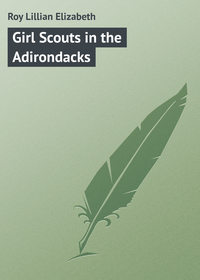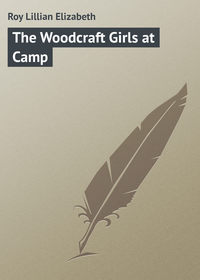 полная версия
полная версияThe Woodcraft Girls in the City
“Now lay the two pieces together and lap so the points at the top are in the same position. Stitch down one selvage for a length of two feet and then straight across to the other selvage, and up to the top again.
“The section left loose is for a door-flap and tapes are to be sewed at places a foot from the bottom and also two feet up from the bottom. Hem each end of bottom and then sew the edges of the sides and slanting top to the sides and roof of the tent-body.
“For the ropes, you have to cut holes about half an inch in diameter right through the folds you stitched down on each side of the roof section. These holes can be bound or button-holed with a string, or those who prefer can use metal eyelets.
“You will need about eight feet of tent-rope for each pole, and a loop of rope should be sewed at the bottom of the tent below each hole to hold down the sides.
“When the tent is completed it should be raised between two straight tree trunks about five or six feet high, or two poles about the same height. A pole about six feet long will answer for the ridge-pole. When these are up, drive some pegs slant-ways into the ground about three feet away from each side of the tent, to fasten the ropes to, and then drive more pegs slant-ways for the loops of rope to slip over and hold firm.
“Now you will have a neat little tent ready for camping, but two important things still remain to be done – can anyone tell me what they are?” asked Miss Miller, as she concluded reading the directions she had written down on a paper.
The girls thought earnestly for a time, but no one seemed to grasp the need of anything else. Finally the Guide said:
“What would happen in case of a heavy rain-storm?”
“Oh, we must dig a trench about the outside for rain!” cried Zan, suddenly realising this important factor in camping.
“Yes, and a floor must be laid to keep us dry from the damp ground!” added Jane.
“I had in mind the gutter for rainwater, but the floor is an important detail, too. I have a second item that is as important as either of the others, though,” continued Miss Miller.
“Miss Miller,” now said Elizabeth Remington, who was visiting the Tribe that afternoon, “If you select a spot high and dry on top of a knoll or hill where the sides carry water down away from your tent, you will not need to trench the circle to draw off rain from the ground where your tent stands. It is a natural water-shed.”
“Ah, I see Elizabeth is a more experienced camper than I am, and I admit that she is better informed than I in this case,” said the Guide, bowing.
“Another good plan, Miss Miller, is to select a place where the sun can shine in in the morning and dry out dampness from the cots and inside of the tent. In case you can’t find a place with a natural water-shed in the ground, then a trench must be dug about a foot wide and nine inches deep, according to the size of your tent. I am figuring on this size tent. This trench should be led away from the doorway just as a leader on a roof carries the water from the building. Also dig a canal for some distance away from the tent to keep the water from backing up when there are sudden heavy showers. Otherwise, your place will be flooded from the over-flow of the trench.”
“Fine! Tell us some more, Elizabeth,” said the Guide.
“Well, mother has experimented and found that in tents made of such thin stuff as you have here, or with duck or ticking, it is advisable to water-proof it before using in camp.”
“That was the second point I wanted the girls to find out and add to the rules,” said Miss Miller, glad to hear the visitor was so well-versed in this work. “Oh, have Betsy tell us how to do it!” cried several girls.
“I have heard but forgotten. Now I’ll get mother to write down the rules and bring it to you another time,” said Elizabeth, sorry she could not oblige the Woodcrafters.
“And if anyone here wishes to know the secret before our next meeting, let her read Edward Stewart White’s ‘Forest,’ or Seton’s ‘Woodcraft Book,’ or the ‘Boy Scout Manual,’,” added the Guide.
“They also explain how to make tepees, Miss Miller,” said Elizabeth.
“Yes, and a tepee is simpler to make than a tent, but this style tent is much roomier and so serviceable.”
That meeting adjourned very promptly as the girls were not as eager to remain late sewing on heavy material as they were when there was dancing or singing.
But the tents were completed in time, and very proud the Woodcrafters felt of the great achievement.
During January, Miss Miller took them to many out-of-town points of interest. Almost every Saturday was spent somewhere where the girls learned many new historical facts, or were able to place incidents heard of in connection with the place visited.
Thus, they visited Edgar Allan Poe’s cottage and the old Revolutionary Mansions left in certain localities of New York.
They took the Hudson Tube to Fulton Street, thence the Broadway subway to 2O7th Street. Here they took a cross-town car to Fordham Road and walked north along the Concourse to Poe Park. The cottage where Poe lived and wrote many of his famous poems is standing here, and directly opposite the cottage is a bust of Poe, erected on the centenary of his birth, January 19th, 1909.
Another trip that cost very little and was most interesting was a visit to Governor’s Island. The boat left the Battery, and on the Island they visited the Military Museum, the Military Prison, the Abandoned Fort, and the Aviation Station. An aeroplane rose and practised even while the Tribe watched it from the Field.
Another Saturday, the Guide started them early in the morning and they visited Sing Sing, watching the men at work at their trades and seeing the wonderful law and discipline maintained there. On the way back from Ossining, they trolleyed to Dobbs’ Ferry and visited the old Washington Headquarters there. It has been purchased and restored to its original interesting state by a loyal American Patriot, who discovered in time that a brewery was negotiating to purchase the estate and turn it into a road-house. Thanks to the generous Patriot, such a desecration was spared the Nation!
One of the outings included visits to historical places in Brooklyn, and the girls were surprised to find many relics of the Revolutionary period still in good order in various sections of this city.
Beginning with February, Mrs. Remington expressed a wish to visit a Council at the Gymnasium and suggest some work to the girls. They immediately replied with an enthusiastic invitation for her to visit them Friday evening.
After preliminaries were disposed of, Mrs. Remington addressed the Tribe.
“Now that you girls have your two Bands in good standing and have a Charter from the League authorising you to be established as Wako Tribe, your next step should be to organise a Little Lodge.
“It behooves a first-class Tribe in good standing to start and supervise a Little Lodge as soon as is reasonable. These little ones can range in age from three to twelve, and are called ‘Brownies.’ They usually are the sisters and brothers or friends of the Big Lodge members. Thus the little children are early taught to be good citizens – as Woodcraft teaches everyone that.
“With the affectionate help from older girls, and the association with and experience from Big Lodges, these Brownies soon acquire an aptness for the things taught their elders. My own little ones, Billy, Edith, and Teddy, have acquired all they know to-day from watching us at home, or mimicking the Woodcraft things they see accomplished by my Tribe, or the Black Bears.
“I have been thinking that my three children, who are not yet twelve, can join your Little Lodge and be of great help to you in successfully founding a Brownie Band of your Tribe. I asked them what they thought of it, and they are delighted with the prospect.”
The Woodcraft girls heartily applauded this idea and Miss Miller thought it a splendid suggestion. She saw the great possibilities it would offer the girls to train themselves in patience, sacrifice, and many other qualities that make for good womanhood.
In an aside to Mrs. Remington she whispered: “Nothing like the responsibility of children to bring out dormant strength of character in a girl!”
“Exactly! That is why this plan was adopted for Big Lodge Girls.”
“We have been discussing this novel plan and we all wish to ask some questions,” now announced the Chief.
“The meeting is open for questions,” said the Guide.
“Can my brother Paul join?” asked Hilda.
“Sure – we’ll soon teach him to quit his peevish ways,” replied Zan, frank but thoughtless in her answer.
Hilda instantly closed her lips tight and looked highly insulted. “The idea of Zan Baker speaking like that of our little Paul!” said she to Nita.
“‘Little Paul’ is almost as old as Billy Remington, but see the awful difference,” retorted Nita, for she disliked the selfish, whining boy as heartily as Zan did.
Hilda turned away but felt ill-treated by her friends. Then Jane Hubert said:
“Maybe my little cousin Dot Hubert will join! Goodness knows she needs this training almost as much as Paul does.”
Some of the girls giggled, for they had noticed Hilda’s offended manner, but Miss Miller quickly added:
“With the three little Remingtons, that will make five. We are progressing splendidly, girls.”
“And I believe I can interest my sister in this Lodge so that Betty and Tammy Fullerton will be allowed to join the Band,” ventured Mrs. Remington.
“How old are they?” eagerly asked the girls.
“Tammy is only a little past three years, and Betty is about seven. Our Teddy is four, Dot Hubert is eight, Edith is nine, Paul is almost eleven, and Billy past eleven, so you see you have a fine range of ages to experiment with.”
“Oh, I’m crazy to see them all together and try to have them to do some Woodcraft stunts!” cried Zan, clasping her hands in delight.
“Let’s hope your enthusiasm keeps up!” grumbled Eleanor, who had not favoured the new departure very much.
The next week the Brownies all attended the weekly meeting and the ceremony of enrolling them as a Little Lodge took place. But as this is all told in detail in the story called “Little Woodcrafters’ Book,” in which the cares and troubles of the self-appointed Woodcraft mothers fill more than 350 pages and are illustrated by numerous pictures, we will omit repeating it in this volume.
With the advent of the Brownies and the conversion of seven active little bundles of mischief into becoming normal, ambitious, coup-winning Woodcrafters, the time flew by as if on wings. Every spare moment found from regular studies and Woodcraft work was filled in by attending to a Brownie need.
Thus February, March, and April came and passed like a mist before the rising sun, and the month of May was ushered in and found the five original girls of Wako Tribe so completely absorbed with the progress the Brownies were making that the other members were ignored and left to work as best they could with the help they could find in the Manual or from Miss Miller.
The Guide saw the unexpected schism created in the ranks of the Tribe, but she had to use utmost wisdom in handling this peculiar situation – all interest shown the Little Lodge by the five girls, and a lack of concern about the new members of their own Big Lodge.
The problem was mentioned to Mrs. Remington and that lady suggested a visit to Council House where Wako Tribe could hold a Grand Council and exhibit work accomplished during the Winter. This was planned to draw the factions together again by a mutual pride and interest in their Tribe activities.
Besides the friends of the members of Wako Tribe, there would be the Black Bears (Fred’s Tribe), Elizabeth’s Tribe, some guests from Headquarters in New York, and a few neighbours of Mrs. Remington’s who were deeply interested in Woodcraft work.
The girls of Wako Tribe were delighted to hold a Spring Council at this place and everyone worked with a will to make the event a memorable occasion. The Guide heaved a deep sigh, for she saw them all united again and seeking the advancement of the Tribe as a unit. But she sighed too soon.
An elaborate programme was evolved and the visitors were impressed by the exhibits of Woodcraft work of every kind made and displayed by the members of the Tribe.
As one entered the Council House a long table was the first attraction. Tomtoms, simple or elaborate according to experience and ability of the makers, beautiful sets of bows and arrows that would carry 100 yards or 150 yards and win coups or grand coups, respectively; fire-sets of rubbing sticks and their leather bags, decorated as the individual preferred; birch-bark articles made from the Alpine harvest of the preceding Fall; many kinds of knots tied in rope and tagged as mentioned in the Manual; individual Tally Books showing what each girl had accomplished since joining the Tribe; and last but not least on this table was an enlarged photograph of the little cabin built on Wickeecheokee Bluff by the five girls during the Summer of their first camp.
Back of the first long table of exhibits, the wall was covered with grass mats, willow beds, decorated blankets, totems, shields, carefully mounted and framed collections of moths, butterflies, insects of various kinds, leaves, flowers, forestry, etc. These made an impressive showing, and many had coups orgrand coups attached.
Next to the long table stood the book-shelves, tabourets, benches, stools, bird-houses, and other decorative or useful articles in carpentry.
A second long table exhibited the pottery work, bowls, fire-urns, candle-sticks, weaving, bead-work, looms, Indian Sun-dial; work in brass, silver, copper, and other metals, the designs made, hammered, and etched by the girls themselves.
Then an old-fashioned bookcase with glass doors had been brought from the house-attic and the shelves of this large cabinet were filled with jars of canned fruit, preserves, pickles, dried and canned vegetables, dried or salted meats, cakes, bread, and other housekeeper’s craft learned and practised by the members of Wako Tribe.
On the floor beside the cabinet were hand-made rush brooms, willow-ware of all kinds, Indian tools for gardening, and the tents made at such expense of labour and patience during January.
There were exhibits of coups and degrees and honours for swimming, star-gazing, farming, archery, nursing, needle-craft, marketing, singing, dancing, Indian Lore, hostess, cooking, fishing, gardening, carpentry, camper-craft, bird sharp, art crafts, and minor works so arranged that the lists seemed endless. In fact, the Big Chief from Headquarters said he had never witnessed so many achievements accomplished by one Tribe in so short a time, and he added that it spoke well for the zeal and application of the members.
The entertainment now began with the usual ceremonies of Grand Council, followed by reports and other business. Then the girls performed the Green Corn Dance, which is especially a Spring Dance. After the Big Lodge finished this graceful dance, the Brownies of the Little Lodge acted Nana-bo-jou with great vim and energy.
Immediately following this dance, the Chief said: “One of our Brownies wishes to win a coup for storytelling, so I will introduce Edith Remington to the audience. She will tell you what happened to her last Winter.”
Edith was acquainted with most of the visitors present, so she felt no self-consciousness in addressing them. In fact, bashfulness and over-sensitiveness are two of the undesirable failings eliminated by Woodcraft, so that a child can do what is expected of it without the agony brought out by self-consciousness.
“It was a very cold day – so cold that the ground was frozen hard – but no snow had fallen yet. I wanted to call Billy ’cause we were invited to spend the day with my little cousins, so I ran out of the front door to find him in the woods at the foot of the lawn.
“Just as I hurried under a big oak tree that stands by the drive, I heard a queer scratching noise, and some loose pebbles flew in front of me.
“I looked over at the foot of the tree-trunk and there was a little squirrel trying to dig up the hard frozen ground. I s’pose he had some nuts buried there and wanted to get them out for his dinner. As I stood watching him for a few minutes, my hands grew cold, so I pulled the mittens out of my coat pocket.
“Out flew a peanut with one of the mittens and no sooner did it roll on the ground than Mr. Squirrel hopped over and had it. He jumped back to the tree and sat upon his haunches cracking and eating the nut.
“He must have been awful hungry, ’cause he hurried back to me the minute he finished the peanut, and jumped upon my arm, looking in my pocket for more.
“I waited, as still as a mouse, so he wouldn’t get ’fraid, then he looked up in my face as much as to say: ‘Haven’t you any more?’
“I laughed at that, and he jumped away and sat a few yards off watching me. Then I had an idea. I ran in and asked Mose for some nuts, telling him about the squirrel. He gave me a handful from the pantry and I ran back to feed the little fellow.
“He came right up and took them from my hands and when he had carted most of them over to the foot of the tree and eaten some, he carried one at a time to a bough and sat eating it. When that was gone he ran down and carried another nut up and ate it.
“I told Billy about it and he said he guessed we could tame that squirrel if we fed it every day. So we gave it things to eat all Winter and now it is as tame as can be.”
When Edith concluded her story the audience applauded and Big Chief declared she must have thecoup, for the story was well told.
Edith was so delighted at hearing this praise from the Chief at Headquarters that she could not be restrained that day – she ran about showing everyone the coup presented her.
The Council ended with the Sunset Song, and the meeting was pronounced to be one of the best Wako Tribe ever held. Miss Miller felt confident that the plan had united all the girls again and now they would work together as before, for the progress and advancement of the entire Tribe.
CHAPTER FIFTEEN – SOME WEEK-END CAMPS
The weather grew warmer with the advancing Spring and out-door life became a joy to the Woodcrafters. The Little Lodge proved to be so entertaining to the five girls that they felt a jealousy of any other member of Wako Tribe should she inadvertently mention a personal interest in the welfare of the Brownies.
Miss Miller saw the breach widening again and was torn ’twixt her desire to keep unity and the struggle to do her duty to both factions. This was the state of affairs when the Chief suggested a one-day’s camp to try out the Little Lodge in the woods.
“Did you hear what Zan Baker’s gone and done?” exclaimed Eleanor Wilbur, as soon as she heard about the proposed camp that Saturday.
“No – what?” demanded some of the girls who were working in the gymnasium while waiting for Miss Miller. The five other girls seldom met at school now, as the Brownies met them at their own homes, thus enabling them to hold aloof from the other members.
“She’s planned a camp and left us out in the cold!”
“Who told you so?” asked some of the loyal girls.
“Oh, I heard it, all right. If you don’t believe me you can ask the Guide when she comes in. Maybe she won’t tell the truth, though, ’cause she is as thick with them as can be, and she is going with them, I s’pose!”
“Well, I can hardly blame Zan and her chums for spending so much time with the Brownies – they are awfully cute, you know!” responded May Randall.
“Besides, the work we have done according to the Manual shows that we can go on just the same, whether the other five girls sit down and wait for us to catch up or not,” said Anne.
“It might be better for all concerned if they fuss over the Brownies while we do the things they all did last year, and then we can all go on together with Woodcraft,” added Frances.
“I might have known you three girls would toady to Zan Baker and Jane Hubert. Just because they run the show and boss us all, doesn’t say they have the right to do it. But you are afraid of them, that’s why you give in every time!” sneered Eleanor.
“At least you will admit that we don’t waste our time going about telling tales on others and trying to make trouble for everyone!” scorned Anne Mason, just as the Guide entered.
Her appearance instantly changed Eleanor’s attitude and she approached Miss Miller with an ingratiating smile. The girls saw and most of them sniffed, some even went so far as to murmur aloud: “Cat! I wish she was out of this Tribe!”
The Guide felt that the atmosphere was charged but she hoped to find out the conditions without questioning, so she started the meeting, explaining the absence of the Chief and four girls by saying:
“They are teaching the Brownies to make gifts for Betty’s birthday party. The little ones are going to the woods to celebrate.”
That same evening, Miss Miller spoke to Zan about having the other members of the Tribe at the Woodland Camp.
“Oh pshaw, Miss Miller! We can’t bother with a crowd of big girls when we are just on the point of trying out this camp-experiment with the Brownies. Those girls have enough to do with their work, and we can go on with the Little Lodge until later.”
“Have you decided on a place for the picnic?” asked the Guide, changing the subject.
“We thought Eagle’s Crest as good as any for just one day,” replied Zan, relieved that the other disagreeable topic was dropped.
“Yes, it is near enough to reach it in an hour’s time by autos, and there will be plenty of birds and flowers and trees to open a mine of Woodcraft for the Brownies.”
“Then it is settled – we will go to Eagle’s Crest. And I will say that some time, when we go to a longer camp-trip, we will ask the new members,” said Zan, apologetically, for she knew the girls of Suwanee Band and her own new members were not receiving the true hospitality demanded of genuine Woodcrafters.
From this conversation, Miss Miller gathered that the five older members were determined to have their own way with the Little Lodge, and she planned now to avert disaster to the Tribe and yet keep them all the best of friends.
Hence the first out-door camp for a day with the Brownies was not announced as a Tribe activity, but it was kept as quiet as possible, declaring it was Betty Fullerton’s birthday party and not a Tribe affair at all. Of course the five old members felt this was downright prevarication, but it seemed the easiest way to rid themselves of unpleasant explanations to the other girls.
To carry out the plan of celebrating Betty’s birthday the last of May, the girls began making gifts to exchange with the Little Lodge members. The Brownies, too, eagerly worked on simple little presents made of paper, paint, and raffia work.
Of course Miss Miller was included in the picnic and she went to keep an alert eye on the conduct and conversation of the older girls as well as watch over the younger children.
From a picnicker’s point of view, the outing was a great success and proved an incentive for a longer camp next time.
On the drive back home that afternoon, Zan asked the other girls when and where they should have the next camp.
“We can revisit Staten Island,” suggested Elena.
“I’d rather camp nearer a house or store where we could telephone if we need to,” added Jane.
“I met a lady this winter who has a house on the Palisades much nearer Fort Lee Ferry than our Alpine Camp was last Fall. She has heard of your Tribe and seemed eager to meet you. I might write and see if she knows of a spot near there,” said Miss Miller.
“Oh do, please, and maybe we can go the first warm Friday.”
“I might add that if the weather is fine we might make a regular Tribe camp of it and all camp over the week-end,” added Miss Miller.
The frowns and scowls that instantly showed on the faces of the five girls plainly told the Guide that the time was not yet at hand for the solving of the unpleasant problem.
At the first stop, which was Miss Miller’s home, Zan said: “Don’t forget that letter, Miss Miller.”
“I won’t, but I must say that you girls ought to pay more attention to individual Woodcraft interests and not so much to your delight in playing with the Brownies. It is downright selfish of you.”









